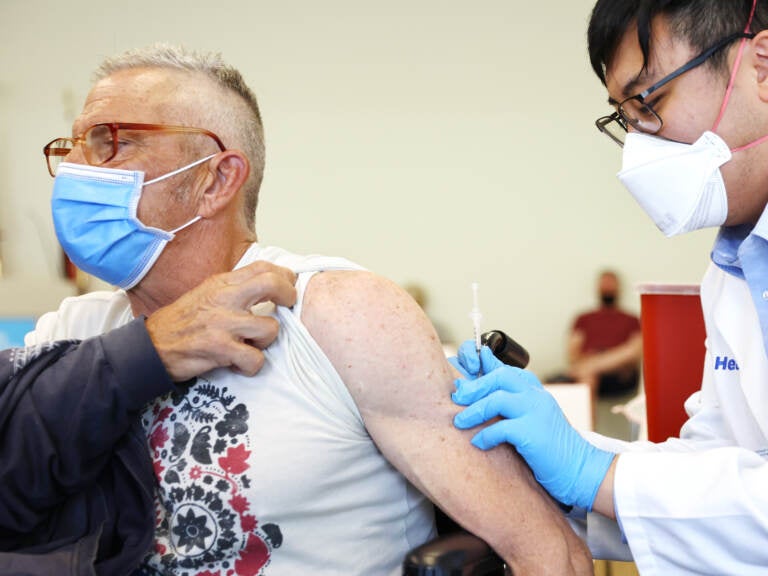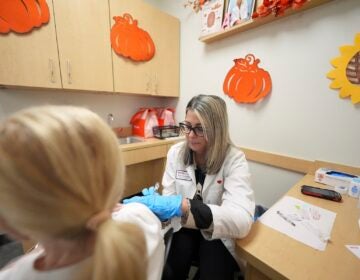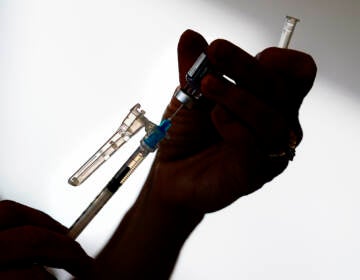Vaccination and awareness could help keep mpox in check this summer

Student pharmacist Charles Liu administered a dose of mpox vaccine at a Los Angeles County Department of Public Health clinic in West Hollywood, Calif., last August. (Mario Tama/Getty Images)
A dozen people came down with mpox in Chicago around early May, prompting the Centers for Disease Control and Prevention to warn doctors of a potential mpox resurgence.
To those that were watching mpox closely, the increase in U.S. cases wasn’t a surprise. New cases had been recently reported in Europe, and U.S. health officials had been warning that low mpox vaccination rates in many parts of the country left at-risk people particularly vulnerable.
“We’ve been beating the drum around the possibility of an increased number of mpox cases for months,” says Dr. Demetre Daskalakis, deputy coordinator of the White House National Mpox Response. “But it wasn’t until the cases in Chicago were reported that people started to say ‘Oh my gosh, we’re at risk for a resurgence.'”
The Chicago outbreak has now grown to more than 30 mpox cases. While those numbers are far lower than last summer, they show that mpox never fully went away.
Health officials say the conditions in the U.S. are ripe for a summer surge, if actions are not taken to avert it.
Low vaccination rates
More than half a million people at risk live in areas with low vaccination rates, according to CDC. This puts them in danger of large, sustained outbreaks that could last for months, if mpox reappears.
During the U.S. outbreak that started last spring, most cases of mpox have been in gay, bisexual and other men who have sex with men. “This is moving primarily through close skin-to-skin contact, often in the context of sexual activity and often related to sexual activity between men,” Daskalakis says.
Cities such as Jacksonville, Fla., Memphis, Tenn., Cincinnati, Baltimore, Houston and Dallas are in counties where many at risk aren’t vaccinated, according to a CDC analysis. Other cities, including San Francisco, New York, and Washington, D.C., are in places with high vaccination rates, where mpox is more likely to be quickly contained if it resurfaces.
Over all, CDC data shows that only around 23% of the 1.7 million people at high risk in the U.S. have been fully vaccinated with two doses of the JYNNEOS vaccine. The disease is disproportionately affecting Black and Latino men, who represent around two-thirds of U.S. cases.
Recent studies found that getting two doses of vaccine is more protective than one. However “even among those who received vaccinations last summer, [many] people who got their first dose of vaccine never returned for their second dose, because they thought we were done with the outbreak,” once case numbers dropped last year, says Dr. Boghuma Titanji, an assistant professor of medicine and an infectious diseases specialist at Emory University.
Prior immunity only partially protects
New evidence also shows that people with prior immunity, either through vaccination or recovering from an infection, can get mpox again.
Many people in the recent mpox clusters in Chicago and abroad in France were fully vaccinated. This does not mean that vaccination isn’t useful, Daskalakis says. So far, the evidence shows that full vaccination is somewhere between 66% and 86% effective at preventing infection – and anecdotally, the new cases of mpox in fully vaccinated people haven’t been severe. “They just have very low-grade infections, some with almost no symptoms,” he says, “If it doesn’t prevent infection, it prevents a lot of the bad stuff that happened in summer 2022.”
While the U.S. has seen low fatalities with mpox, it can cause serious illness. “It’s still a disease that can be disfiguring. It can cause severe pain, and for people who are immunocompromised can even be fatal. It’s not a trivial occurrence,” Titanji says.
As Pride Month starts, health officials are urging revelers to promote good health. “Pride is the opportunity to reach out to people and prevent impacts,” Daskalakis says. Those who are eligible for mpox vaccination should get their two doses. Everyone – including those who had mpox before – should be aware of the risk. “If you got a funny rash, it could be mpox, so go get tested,” he says, adding that tests are much more plentiful and easier to get than last summer.
From Daskalakis’ perspective, there appears to be a storm brewing. Low vaccination rates, prior immunity that’s only partially protective, and warm weather partying could combine to give mpox opportunities to spread — but there are also ways to limit the impacts of that storm. “Models are an attempt to forecast the future, and action is our ability to change the future,” he says. Improving vaccination rates and awareness among those at risk could prevent a widespread summer surge.
9(MDAzMzI1ODY3MDEyMzkzOTE3NjIxNDg3MQ001))




